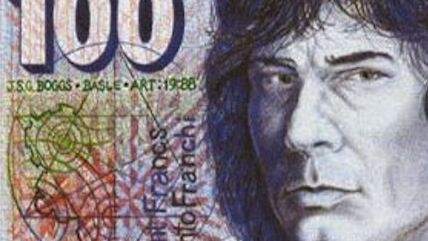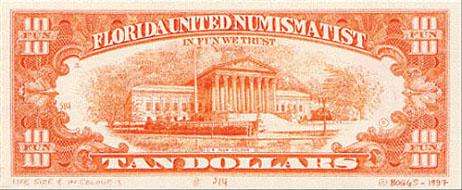The Man Who Made His Own Money
J.S.G. Boggs, RIP


J.S.G. Boggs, who just died at age 62, was an artist whose career doubled as an extended economic experiment. Starting in the 1980s, he drew money. I don't mean that he drew scenes with money in them. I mean he drew actual pieces of currency, and then tried, often successfully, to spend them.
Put that way, he may sound like a counterfeiter. More than once, he got into trouble with law enforcement officials who were convinced he was a counterfeiter. But he wasn't. The cash he created was obviously his own invention, with both large and small differences from legal tender (like, say, having a dollar bill feature Martha rather than George Washington, or say 'THE UNITED STATES OF FLORIDA' instead of 'THE UNITED STATES OF AMERICA'). And he was always upfront about what he was doing. No one ever took a Boggs bill thinking she was getting a Federal Reserve note—and once his career got off the ground, anyone who accepted a Boggs bill would almost immediately be contacted by collectors eager to pay through the nose for it.
Essentially, Boggs was issuing his own currency, backed by the full faith and credit of the art market. In the process, he raised a slew of fascinating questions about just what money is and what gives it value.

Boggs' work eventually inspired one of my favorite books about either money or art, Lawrence Weschler's Boggs: A Comedy of Values. Not long after that came out, I interviewed Boggs for Reason. It wasn't exactly in-depth—just a one-page Q&A that ran in the books & culture section under the now-regrettable headline 'The Art of the Deal'—but it did give me a chance to ask, 'If I drew a dollar bill and signed your name to it, would I be a forger or a counterfeiter?' (His answer: a forger. 'I don't make money; I make works of fine art.')
After the Secret Service seized a bunch of Boggs' drawings and other property in 1992, he entered a long battle to get them back, financing his legal battles with—of course—his DIY cash-art. When he died, he was trying to get a hearing before the U.S. Supreme Court. The process, Weschler wrote, was a 'peculiarly hilarious nightmare of a case in which both sides were in a position to cover and go on covering all their costs simply by printing fresh money.'


Show Comments (31)